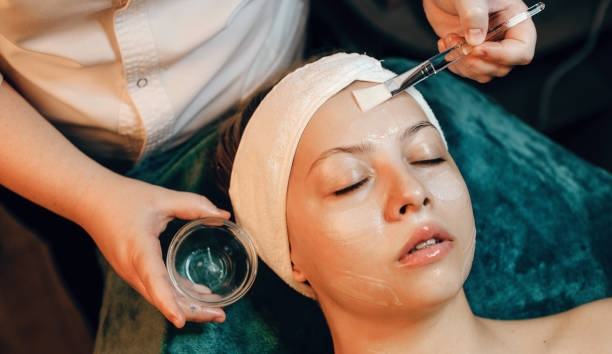
Pigmentation issues affect many individuals, causing uneven skin tone, dark spots, and discoloration. These changes often arise due to factors such as sun exposure, hormonal fluctuations, aging, and skin inflammation. Addressing pigmentation effectively requires treatments that target the underlying causes while promoting healthy skin renewal.
What Are Chemical Peels and How Do They Work?
Chemical peels are cosmetic treatments that use specialized acid solutions to exfoliate the skin’s outer layers. This process encourages the shedding of damaged skin cells and stimulates new cell growth. By accelerating skin renewal, chemical peels help fade pigmentation, improve texture, and enhance overall complexion. The treatment varies in strength depending on the skin’s needs, from superficial to deep peels.
Why Choose Chemical Peels in Riyadh for Pigmentation Care?
Choosing Chemical Peels in Riyadh offers access to advanced skincare techniques designed to treat pigmentation effectively. The region’s dermatology experts utilize customized peel formulas suited to diverse skin types and pigmentation patterns. With Riyadh’s climate often contributing to sun-related pigmentation, these treatments help counteract damage and restore an even skin tone.
Types of Chemical Peels Used for Pigmentation
Chemical peels come in various forms, each with unique benefits for pigmentation care. Glycolic acid peels gently exfoliate and brighten skin, making them ideal for mild pigmentation. TCA (trichloroacetic acid) peels penetrate deeper, targeting stubborn dark spots and uneven pigmentation. Jessner’s peel combines multiple acids for enhanced exfoliation and is popular for treating complex pigmentation issues.
Preparing for Your Chemical Peel Treatment
Proper preparation is essential to maximize the benefits of chemical peels and reduce side effects. Patients are advised to avoid direct sun exposure and certain skincare products that increase skin sensitivity before treatment. A thorough skin assessment helps determine the right peel type and strength to match pigmentation concerns safely.
What to Expect During and After the Procedure
During the chemical peel, the acid solution is carefully applied to the skin and left for a specified time before being neutralized or removed. Sensations may include mild stinging or warmth, which typically subside quickly. Post-treatment, the skin may peel or flake as it renews. Following aftercare instructions, such as moisturizing and sun protection, supports healing and enhances results.
Benefits of Chemical Peels for Pigmentation in Riyadh
One of the key advantages of Chemical Peels in Riyadh is their ability to significantly reduce hyperpigmentation, including melasma, sun spots, and age spots. These treatments improve skin texture, minimize fine lines, and promote a radiant complexion. Many find chemical peels to be a cost-effective and non-invasive option compared to other pigmentation therapies.
Who Is a Good Candidate for Chemical Peels?
Ideal candidates for chemical peels are individuals seeking to improve pigmentation without invasive surgery. Those with mild to moderate pigmentation issues, uneven skin tone, or sun damage can benefit greatly. However, it is important to have realistic expectations and to consult with skincare professionals who can tailor treatments to individual skin conditions.
Potential Side Effects and Safety Considerations
Chemical peels are generally safe when performed by qualified practitioners, but some side effects can occur. These include temporary redness, peeling, or increased sensitivity. More severe reactions are rare but may happen, especially with deeper peels. Following professional guidance and proper aftercare minimizes risks and ensures safe recovery.
Combining Chemical Peels with Other Pigmentation Treatments
For enhanced results, chemical peels may be combined with other skincare treatments like laser therapy, microdermabrasion, or topical agents. This multimodal approach can address pigmentation on several levels, boosting skin clarity and overall appearance. Customized treatment plans optimize outcomes for each patient.
Maintaining Results After Chemical Peel Treatment
Maintaining the benefits of Chemical Peels in Riyadh involves consistent skincare routines and lifestyle habits. Regular use of sunscreen is crucial to protect renewed skin from further pigmentation caused by UV rays. Hydrating and gentle skincare products help preserve the skin’s health and prolong the peel’s effects.
Importance of Professional Guidance
Choosing experienced skincare professionals ensures safe and effective pigmentation treatment through chemical peels. Experts assess skin type, pigmentation severity, and medical history before recommending personalized treatment plans. Professional care also helps manage expectations and provides the best path to achieve clearer, even-toned skin.
Frequently Asked Questions
What is the difference between superficial and deep chemical peels for pigmentation?
Superficial peels exfoliate the outermost skin layers and are suitable for mild pigmentation, while deep peels penetrate further and target more stubborn pigmentation but require longer recovery.
How many sessions of chemical peels are needed to see improvement in pigmentation?
The number of sessions varies by individual, but most see visible improvements after multiple treatments spaced several weeks apart to allow skin healing.
Can chemical peels be performed on all skin types for pigmentation?
Yes, but treatment must be customized. Darker skin tones require gentle peels to avoid complications like post-inflammatory hyperpigmentation, so expert evaluation is vital.
Is sun exposure a concern after chemical peel treatment for pigmentation?
Absolutely. Avoiding sun exposure and using broad-spectrum sunscreen is critical after treatment to prevent new pigmentation and protect sensitive skin.